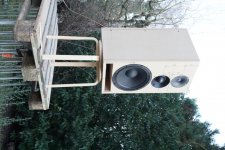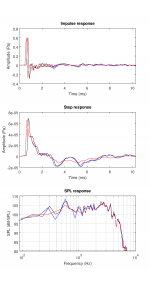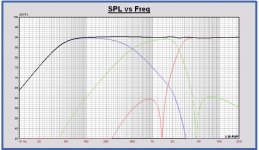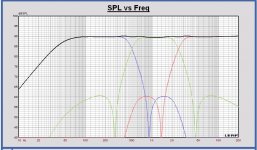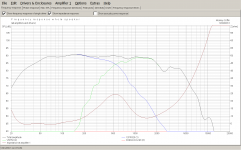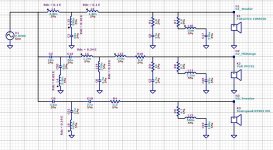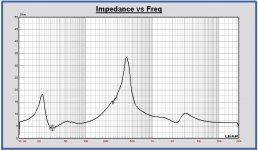What is your concept idea for the x-over? Still following the lines of post 119?
I prefer high slope xo filtering. Together with a friend I have done many comparing tests Butterworth first, second, third order, LR2, LR4 and elliptical filtering 3rd and 5th order.
The higher order ones are the best in our opinion.
With the lower orders the sound becomes more warm, not so refined and not so well timed.
I think using low order and not designing perfect on target outband, affects timing. That is my personal explanation for the different sound.
And of course the wider overlap with lower order filters will affect the sum response of the drivers more off axis with impact on the sound color in a room.
But if a high order xo is designed not well on target, it can sound really bad. The lower orders are less critical on that point.
It is not my speaker and I have no problem with other concepts. 🙂
My proposal is LR4 or 3rd order elliptical (EL3) as a trial, for both xo points.
Elliptical filtering creates more life experience in the sound. It has to be designed very well, otherwise it becomes aggressive. Critical design.
Elliptical 5th order is not possible with a passive design, too complex. For digital designs, no problem...
Last edited:
The higher order ones are the best in our opinion.
With the lower orders the sound becomes more warm, not so refined and not so well timed.
What do you mean by "timing"? Is this about how you experience the music?
I guess the time domain response would be "best" with first-order filters, because they don't split a pulse signal into two pulses that are separated in time (one pulse for the high pass and one for the low pass). I like how first-order filters keep the time domain intact. However, I am not sure such slow roll off filters would work out well here.
I am really curious to see the x-over suggestions / ideas!
Yes by timing I mean the experience that you get in music. Musical attacks sound more fast, more dynamic, with high order filters. Lower order like a Butterworth 2nd order for example sounds more warm, more smoothed, lazy.
I agree about the statement about timing for a first order filter, technical. On axis it is the only filter that is ok w.r.t. flat SPL, flat power and linear phase. I am afraid it cannot be realized well on a first order filter target, because driver responses have to be compensated to fit on target outband also. The vertical off axis response of a first order is heavily affected by the very wide overlap.
We have tried out first order designs with a digital design to make it as good as possible. Typical is, if you listen on axis to one speaker the sound of the individual drivers cannot be heard, it sounds like one integrated driver. That is a very good point. But the overall sound in the room is affected, its sound is warm and slightly colored. Personally I don't like, it becomes annoying after some time. It is not clean enough. I think the reason for that is the affected off axis response by the wide overlap zones and affecting early reflections.
I agree about the statement about timing for a first order filter, technical. On axis it is the only filter that is ok w.r.t. flat SPL, flat power and linear phase. I am afraid it cannot be realized well on a first order filter target, because driver responses have to be compensated to fit on target outband also. The vertical off axis response of a first order is heavily affected by the very wide overlap.
We have tried out first order designs with a digital design to make it as good as possible. Typical is, if you listen on axis to one speaker the sound of the individual drivers cannot be heard, it sounds like one integrated driver. That is a very good point. But the overall sound in the room is affected, its sound is warm and slightly colored. Personally I don't like, it becomes annoying after some time. It is not clean enough. I think the reason for that is the affected off axis response by the wide overlap zones and affecting early reflections.
Last edited:
The difference between low and high order can be expressed very simple like this.
With a low order filter you are listening more to the sum of filtered drivers playing together as one source.
With high order filtering drivers can play more on its own, the zones where the drivers are playing together is much smaller.
I think that creates a different signature in the sound.
It looks like the music is more smeared out in time with low order, because of all the time delays off axis in wide overlap zones.
Remark, this is all my personal perception of it, trying to explain the differences in the sound.
With a low order filter you are listening more to the sum of filtered drivers playing together as one source.
With high order filtering drivers can play more on its own, the zones where the drivers are playing together is much smaller.
I think that creates a different signature in the sound.
It looks like the music is more smeared out in time with low order, because of all the time delays off axis in wide overlap zones.
Remark, this is all my personal perception of it, trying to explain the differences in the sound.
My sweet spot is LR2 or elliptical Duelundish slopes (acoustic). I agree with Paul's listening experiences, LR4 is very clean but too clean and cold to my taste! Might depend on room RT30 and EDT values too, my T30 is around 0.4 -0.5.
I too have tried many topologies with minidsp in 2,3- and 4-way speakers, with equalized on-axis response. The difference is in off-axis and perhaps also IMD when overlap is wide. With LR2 one must be careful not to drive low end of mid and tweeter to high distortion.
I too have tried many topologies with minidsp in 2,3- and 4-way speakers, with equalized on-axis response. The difference is in off-axis and perhaps also IMD when overlap is wide. With LR2 one must be careful not to drive low end of mid and tweeter to high distortion.
Juhazi,
I can agree with you, LR4 is sounding a little too clean and thin also for my taste.
Therefore the Butterworth 3th order is better, but a little too warm sound for me.
I find the elliptical 3rd order filter the best compromise.
LR2 for tweeter and midrange no so well IMO. In most cases there is a power dip at the xo point. I have no good experiences with it, such speaker is playing too quiet for me, I call it a dark speaker.
I can agree with you, LR4 is sounding a little too clean and thin also for my taste.
Therefore the Butterworth 3th order is better, but a little too warm sound for me.
I find the elliptical 3rd order filter the best compromise.
LR2 for tweeter and midrange no so well IMO. In most cases there is a power dip at the xo point. I have no good experiences with it, such speaker is playing too quiet for me, I call it a dark speaker.
To understand why a LR filter is sounding more cool than a odd Butterworth B3 or B1 is the power response in the room.
LR filters are in phase and - 6dB at xo point. The SPL is maximum on axis and decreases off axis. For xo frequency points where the wavelength of the sound becomes equal or smaller than the distance between the drivers, a power dip appears and less power is radiated to the room.
Odd Butterworth filters are in phase quadriture and - 3 dB at xo point. The SPL is not maximum on axis but off axis, because the drivers become more and more in phase off axis. The SPL peak can become +3dB maximum off axis, if the wavelength of the sound becomes equal or smaller than the distance between the drivers. The power response of such filters is flat at x-over. So, more power can be radiated into the room and also with a flat SPL on axis.
That is the reason of the different sound between both concepts.
LR filters are in phase and - 6dB at xo point. The SPL is maximum on axis and decreases off axis. For xo frequency points where the wavelength of the sound becomes equal or smaller than the distance between the drivers, a power dip appears and less power is radiated to the room.
Odd Butterworth filters are in phase quadriture and - 3 dB at xo point. The SPL is not maximum on axis but off axis, because the drivers become more and more in phase off axis. The SPL peak can become +3dB maximum off axis, if the wavelength of the sound becomes equal or smaller than the distance between the drivers. The power response of such filters is flat at x-over. So, more power can be radiated into the room and also with a flat SPL on axis.
That is the reason of the different sound between both concepts.
Last edited:
LR filters have their uses, but not what I'd choose for mid/tweet in this setting.
2nd order Bessel can work well at most frequencies, depends on implementation, offsetting xo points can help.
High order Elliptical is nice at high-ish frequencies (I like them over ca 700hz), and very good sounding when done correctly.
Worst filter ringing in a setup I ever heard was 11th order Elliptic at 120-200hz somewhere (do not remember exactly)...
2nd order Bessel can work well at most frequencies, depends on implementation, offsetting xo points can help.
High order Elliptical is nice at high-ish frequencies (I like them over ca 700hz), and very good sounding when done correctly.
Worst filter ringing in a setup I ever heard was 11th order Elliptic at 120-200hz somewhere (do not remember exactly)...
What about the bear containers...?
Just a quick flashback regarding my beloved beer crates.
I wanted to understand the cause for the large dips/peaks around 400 Hz. I replaced the beer crates by a stool (see attached photo) and repeated the outdoor measurements of the woofer (spoiler alert: there was no 400 Hz artefact with the midrange driver!). Indeed, the effect was less without the crates -- but it was not gone (black curves in attached figure).
Maybe a resonance between the bottom of the box and the palette (i.e., "inside the stool")? I kicked out the stool, which meant the box and microphone were now closer to the floor. With the mic at 200cm above the floor and 50cm from the baffle, I got a 10.3 ms long anechoic impulse response. This gives a frequency resolution of better than 100 Hz, which is still useful. The dip/peak was still there, no change (blue curves).
Maybe internal resonances in the Monkey Coffin box? I stuffed the port with a scarf (red curves) and voila, MUCH better! We'll have to deal with this resonance somehow. Hopefully, some damping material is all we need.
Ok, now that we understand the acoustics of my beer crates, let's go back to the discussion of the x-over for the Monkey Coffin!
Attachments
Ok, filter types: LR does not seem to be a favourite here (with LR2 maybe a bit better than than LR4). Elliptic, odd-order Butterworth, and Bessel types seem to be preferred soundwise.
I guess we should also keep in mind that we are not developing an active filter using opamps or DSPs. We're designing a conventional passive filter for the Monkey Coffin. This means we should try to constrain ourselves a bit in terms of circuit complexity (these large caps and inductors are usually far from perfect, and it pays off to not have too many of them between the amp and the drivers). The drivers don't have nasty breakup resonances and we're not aiming at at very high power applications.
Is 3rd order a reasonable maximum in terms of circuit complexity?
I guess we should also keep in mind that we are not developing an active filter using opamps or DSPs. We're designing a conventional passive filter for the Monkey Coffin. This means we should try to constrain ourselves a bit in terms of circuit complexity (these large caps and inductors are usually far from perfect, and it pays off to not have too many of them between the amp and the drivers). The drivers don't have nasty breakup resonances and we're not aiming at at very high power applications.
Is 3rd order a reasonable maximum in terms of circuit complexity?
Here the update of the SPL frd's.
I have done a data splice now with the outdoor measurements of Matthias.
woofer spliced at 700 Hz
midrange spliced at 350 Hz
tweeter spliced at 500 Hz
In attach plots and SPL frd. Impedance frd's can be found in post 479.
I have done a data splice now with the outdoor measurements of Matthias.
woofer spliced at 700 Hz
midrange spliced at 350 Hz
tweeter spliced at 500 Hz
In attach plots and SPL frd. Impedance frd's can be found in post 479.
Attachments
-
20181228 ScanR2904+WG148 MonkeyBox SPL 1m 0deg 2.83V.txt20.7 KB · Views: 77
-
20181228 Volt VM752 MonkeyBox SPL 1m 0deg 2.83V.txt23.8 KB · Views: 78
-
20181228 Faital Pro 12PR320 MonkeyBox SPL 1m 0deg 2.83V.txt24.2 KB · Views: 88
-
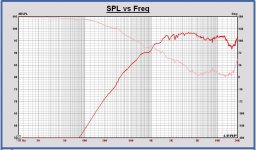 20181228 Monkey Box SPL tweeter - splicing meas outdoors.JPG147.1 KB · Views: 436
20181228 Monkey Box SPL tweeter - splicing meas outdoors.JPG147.1 KB · Views: 436 -
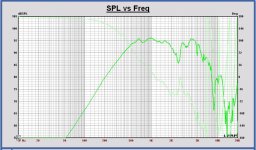 20181228 Monkey Box SPL midrange - splicing meas outdoors.JPG141.8 KB · Views: 447
20181228 Monkey Box SPL midrange - splicing meas outdoors.JPG141.8 KB · Views: 447 -
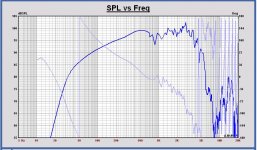 20181228 Monkey Box SPL woofer - splicing meas outdoors.JPG154.5 KB · Views: 452
20181228 Monkey Box SPL woofer - splicing meas outdoors.JPG154.5 KB · Views: 452
Ok, now that we understand the acoustics of my beer crates ...
Good to know the reason of the 400 Hz resonance, that it is not caused by the beer crates ( and not the bear containers like I wrote 🙂 )
LR filters have their uses, but not what I'd choose for mid/tweet in this setting.
2nd order Bessel can work well at most frequencies, depends on implementation, offsetting xo points can help.
High order Elliptical is nice at high-ish frequencies (I like them over ca 700hz), and very good sounding when done correctly.
Worst filter ringing in a setup I ever heard was 11th order Elliptic at 120-200hz somewhere (do not remember exactly)...
Hi Kaffimann,
Concerning a second order Bessel xo. The sum response is not flat, some boost at the xo frequency. To make it flat you can choose a different xo frequency for low and high pass section. That is what you mean by offsetting probably.
In the past I used such offset also with a Butterworth 2nd order to avoid the 3dB boost of that filter. It was good, but I find the higher order filters better now.
11th order elliptical at 120-200 Hz? Problem is the high groupdelay of the elliptical filters at low frequencies. 5th order elliptical, I don't use below 300Hz. For lower frequencies I use LR filters, for example a subwoofer filter.
Yes Paul, we have some similar experiences it seems.
3rd order elliptic might work well to 300hz, I don't know. But on 4th order or higher I prefer LR up to 700hz, then 5th order elliptic takes over from 700hz and up, for the high order filters.
Bessel must have offset xo points, yes, the Rane paper on filters was a good help for me in this regard, can give a very coherent response.
I do think high order BW can have some advantages for low freq xo.
3rd order elliptic might work well to 300hz, I don't know. But on 4th order or higher I prefer LR up to 700hz, then 5th order elliptic takes over from 700hz and up, for the high order filters.
Bessel must have offset xo points, yes, the Rane paper on filters was a good help for me in this regard, can give a very coherent response.
I do think high order BW can have some advantages for low freq xo.
The less complex higher order filter is a 3rd order Butterworth filter.
For a third order elliptical filter for both xo points, 2 extra coils are needed (2 big and 1 small) and an extra cap in the tweeter filter.
The combination 2nd order Bessel at 500 Hz and 3rd order elliptical at 2500 Hz (Kaffimann proposal) has IMO the disadvantage that the midrange SPL passband is not flat.
Comparing with elliptical 3rd order at both 500 Hz and 2500 Hz, the midrange is flat in the passband. Also the overlap zones are much smaller with the elliptical version.
In attach the targets of both concepts. As low frequency target, it is a 2nd order high pass filter at 45 Hz, Q = 0.7, just to have some reference in the target.
If a driver passband is not flat, you can hear it close to the speaker that it isn't a flat response for that driver. Of course at listening distance it will be compensated by a second driver. But I don't prefer it, something wrong in my head maybe 😕. In that way I like the flat passbands for each driver or same filter concept for low and high xo point. I just give my opinion...
For more simple filtering with less components lower order filtering has to be chosen.
Maybe Bessel 2nd order at 500 and 2500 Hz with some offsets on the low and high pass sections to make SPL flat.
For a third order elliptical filter for both xo points, 2 extra coils are needed (2 big and 1 small) and an extra cap in the tweeter filter.
The combination 2nd order Bessel at 500 Hz and 3rd order elliptical at 2500 Hz (Kaffimann proposal) has IMO the disadvantage that the midrange SPL passband is not flat.
Comparing with elliptical 3rd order at both 500 Hz and 2500 Hz, the midrange is flat in the passband. Also the overlap zones are much smaller with the elliptical version.
In attach the targets of both concepts. As low frequency target, it is a 2nd order high pass filter at 45 Hz, Q = 0.7, just to have some reference in the target.
If a driver passband is not flat, you can hear it close to the speaker that it isn't a flat response for that driver. Of course at listening distance it will be compensated by a second driver. But I don't prefer it, something wrong in my head maybe 😕. In that way I like the flat passbands for each driver or same filter concept for low and high xo point. I just give my opinion...
For more simple filtering with less components lower order filtering has to be chosen.
Maybe Bessel 2nd order at 500 and 2500 Hz with some offsets on the low and high pass sections to make SPL flat.
Attachments
Last edited:
The less complex higher order filter is a 3rd order Butterworth filter ... The combination 2nd order Bessel at 500 Hz and 3rd order elliptical at 2500 Hz (Kaffimann proposal) ... Comparing with elliptical 3rd order at both 500 Hz and 2500 Hz
Just looking at the curves, I like how the elliptic+elliptic concept (second plot) squeezes out most of the VM752 dome goodness, with less overlap to the woofer. The sharp cutoff of the dome towards the tweeter may also help dealing with the baffle diffraction dip of the midrange at 2.4 kHz.
What about the 3rd order Butterworth option? What are your opinions about this compared to the elliptic filters (transfer functions, perceived sound, circuit complexity, etc.)?
I am not so much into filter theory, and it would be useful for me to see a sketch of the respective filter schematics to understand how complex the respective circuits would be.
In the meantime I just impelemented the filter circuit of post 119 with no modification using the spliced SPL curves of post 511 using Visaton BoxSim (an older program which I found a while back, and it's simple enough for me to work with). Woofer and midrange only for now. The result is surprisingly good, given that this circuit was based on modelled SPL curves only.
Attachments
I will prepare some practical schematics of Butterworth 3rd order (B3) and elliptical 3rd order (EL3). Then the complexity of both can be compared.
My personal opinion about B3 versus EL3. The B3 is very musical, it plays warmer and more powerful than a LR4. B3 fills the room more with music than the LR4, which has a more modest behavior. B3 is not annoying on long term.
B&W is using B3 in a lot of his speakers for both midrange and tweeter, as an information.
The EL3 targets I have created myself. I have tried to make SPL as flat as possible with an overlap zone as small as possible. There are also other EL3 versions, but these are my own. There is a little xo frequency offset on the low and high frequency part to make SPL flat together with that small overlap zone. The phase difference at xo is 20 degrees in this way. For the polar diagram it is a little worse than LR but better than the odd Butterworth.
EL3 has the same sound color as B3, but it plays with faster dynamics in the music, which gives a better life experience. Fast attacks in the music.
Exaggerating a little, B3 plays a little more lazy and enthusiastic than the EL3. Elliptic is much more fascinating. I don't want anything else anymore.
A friend of me plays now EL5, implemented digital. It is the same sound as EL3, but even more refined.
I did the same test with the LR4 filter of post 119 using the last frd's. Surprising good yes and the SPL curves were based only on the datasheet info.
My personal opinion about B3 versus EL3. The B3 is very musical, it plays warmer and more powerful than a LR4. B3 fills the room more with music than the LR4, which has a more modest behavior. B3 is not annoying on long term.
B&W is using B3 in a lot of his speakers for both midrange and tweeter, as an information.
The EL3 targets I have created myself. I have tried to make SPL as flat as possible with an overlap zone as small as possible. There are also other EL3 versions, but these are my own. There is a little xo frequency offset on the low and high frequency part to make SPL flat together with that small overlap zone. The phase difference at xo is 20 degrees in this way. For the polar diagram it is a little worse than LR but better than the odd Butterworth.
EL3 has the same sound color as B3, but it plays with faster dynamics in the music, which gives a better life experience. Fast attacks in the music.
Exaggerating a little, B3 plays a little more lazy and enthusiastic than the EL3. Elliptic is much more fascinating. I don't want anything else anymore.
A friend of me plays now EL5, implemented digital. It is the same sound as EL3, but even more refined.
I did the same test with the LR4 filter of post 119 using the last frd's. Surprising good yes and the SPL curves were based only on the datasheet info.
Last edited:
Here we are, elliptical 3rd order xo at 500 and 2500 Hz.
Just a first design to show concept and complexity, not optimized, but already very good behaving. Not looked in detail to phase, off axis,...
Minimum impedance is 4.36 Ohm at 31 Hz.
This filter cannot be made less complex.
For a B3: L13 in woofer filter, C20 and L14 in midrange filter and C21 in tweeter filter can be removed.
Chosen air core coils with DC resistances for 1.4mm2 wire. The serial coils of woofer filter with core.
DC resistances of coils for impedance compensation can be higher of course.
In attach schematic, SPL and impedance response.
Just a first design to show concept and complexity, not optimized, but already very good behaving. Not looked in detail to phase, off axis,...
Minimum impedance is 4.36 Ohm at 31 Hz.
This filter cannot be made less complex.
For a B3: L13 in woofer filter, C20 and L14 in midrange filter and C21 in tweeter filter can be removed.
Chosen air core coils with DC resistances for 1.4mm2 wire. The serial coils of woofer filter with core.
DC resistances of coils for impedance compensation can be higher of course.
In attach schematic, SPL and impedance response.
Attachments
Last edited:
Here we are, elliptical 3rd order xo at 500 and 2500 Hz.
Just a first design to show concept and complexity, not optimized, but already very good behaving. Not looked in detail to phase, off axis,...
Minimum impedance is 4.36 Ohm at 31 Hz.
Ok, this has only a few more parts than the one in post 119, and most of them are in the parallel branches "only". I can hear some people complain about too much complexity, but it does seem okay to me. Let's look into this a bit more!
The on-axis SPL looks phantastic! I wonder what it does off axis...
Can the 31 Hz impedance dip be improved to get closer to the "8 Ohm" rating (6.4 Ohm min.)? How about making the impedance compensation of the upper bass-reflex peak a bit more narrow (higher Q of the LCR), and use a larger R in the LCR?
Can the 31 Hz impedance dip be improved to get closer to the "8 Ohm" rating (6.4 Ohm min.)? How about making the impedance compensation of the upper bass-reflex peak a bit more narrow (higher Q of the LCR), and use a larger R in the LCR?
Why not using air core coils in the woofer filter with about 1.5 Ohm extra serial resistance and the air core coils are much better. But the SPL in passband will be 1 dB lower. Minimum impedance will become 6 Ohm. Maybe doing it like that, IMO the best solution. Changing LCR will affect SPL response.
In the final filter also a parallel LCR should be added at the input, to decrease the impedance peak at 400 Hz. For the tube amps with high output impedance. It can be optional.
Last edited:
- Home
- Loudspeakers
- Multi-Way
- Open Source Monkey Box
